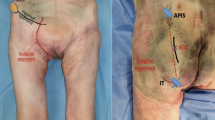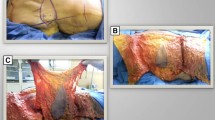Abstract
Knowing the vascular network and properties of the vascular pedicle is of crucial importance for elevation of the tensor fascia lata (TFL) transpositional or free flap; therefore, the origin of the lateral circumflex femoral artery (LCFA), its diameter at the site of origin, the length of the vascular pedicle, the number of lateral branches, the number of terminal branches and the anastomosis of the LCFA ascending branch are of utmost importance for successful elevation and clinical application of this flap. The study was conducted on clinical (100 angiographic images of the femoral artery) and autopsy (48 preparations) material. The first part of the study comprised analysis of the angiographic images that were used to obtain the information on LCFA. The diameter of LCFA at its origin was measured to be 0.44 cm, while it was 0.33 cm at the origin of ascending branch. The mean value of the diameter at the bifurcation of the terminal branches of ascending branch (inside tensor fascia lata muscle) was 0.24 cm. It has been established that the vascular pedicle of the tensor fascia lata flap (ascending branch of LCFA) is anastomosed with the superior gluteal artery in all cases. Measurement of the tensor fascia lata muscle revealed an average length of 15.91 cm, width of 3.55 cm and thickness of 1.98 cm. Injection of colour-ink into the ascending branch LCFA that enters directly into the TFL muscle was used to measure the extent of the TFL flap vascularization and on the average, the TFL flap was 20.32 cm long and 16.57 cm wide while the surface was 17.52 cm3.






Similar content being viewed by others
References
Bhathena HM, Kavarana NM (1993) One stage reconstruction of extensive abdominal wall defect with bilateral tensor fascia lata (TFL) flaps. Indian J Cancer 30:10–15
Endo T, Nakayama Y, Soeda S (1991) Reconstruction of the cheek and palate using a three-paddle tensor fasciae latae free flap. Br J Plast Surg 44:234–235
Mathes JS, Nahai F (eds) (1982) Clinical applications for muscle and musculocutaneous flaps. Mosby, St. Louis, pp 99–151
Mathes JS, Nahai F (eds) (1979) Clinical atlas of muscle and musculocutaneous flaps. Mosby, St. Louis, pp 63–68
Muller-Vahl H (1985) Isolated complete paralysis of the tensor fasciae latae muscle. Eur Neurol 24:289–291
Nahai F, Hill L, Hester TR (1979) Experiences with the tensor fascia lata flap. Plast Recons Surg 63:788–799
Guignard RM, Krupp S (1986) The role of microvascular free soft tissue transfer in reconstructive surgery. Ann Plast Surg 16:399–409
Meland NB, Weimar R (1991) Microsurgical reconstruction: experience with free fascia flaps. Ann Plast Surg 27:1–8
Nystrom A, Hanel DP, Scheker L, Schwartz KS, Lister GD (1990) Free flap circulation and modes of arterial insertion: an experimental study. Microsurgery 11: 265–267
Wei FC, Demirkan F, Chen HC, Chen IH (1999) Double free flaps in reconstuction of extensive composite mandibular defects in head neck cancer. Plast Reconstr Surg 103:39–47
Endo T, Nakayama Y (1997) Pharyngoesophageal reconstruction: a clinical comparison between free tensor fasciae latae and radial forearm flaps. J Reconstr Microsurg 13:93–97
McCraw JB, Arnold GP (eds) (1986) McCraw and Arnold’s Atlas of Muscle and Musculocutaneous Flaps. Hampton, Norfolk pp 423–443
Kimata Y, Uchiyama K, Ebihara S, Nakatsuka T, Harii K (1988) Anatomic variations and technical problems of the anterolateral thigh flap: a report of 74 cases. Plast Reconstr Surg 102:1517–1523
Penington AJ, Theile DR, MacLeod AM, Morrison WA (1996) Free tensor fasciae latae flap reconstruction of defects of the chest and abdominal wall: selection of recipient vessels. Scand J Plast Reconstr Surg Hand Surg 30:299–305
Saadeh FA, Haikal FA, Abdel-Hamid FA (1998) Blood supply of the tensor fasciae latae muscle. Clin Anat 11:236–238
Kimata Y, Uchiyama K, Sekido M et al (1999) Anterolateral thigh flap for abdominal wall reconstruction. Plast Reconstr Surg 103:1191–1197
Yousif NJ, Ye Z (1991) Analysis of cutaneous perfusion: an aid to lower extremity reconstruction. Clin Plast Surg 18:559–570
Ercocen AR, Apaydin I, Emiroglu M et al (1998) Island V-Y tensor fasciae latae fasciocutaneous flap for coverage of trochanteric pressure sores. Plast Reconstr Surg 102:1524–1531
Depuydt K, Boeckx W, D’Hoore A (1998) The pedicled tensor fasciae latae flap as a salvage procedure for an infected abdominal mesh. Plast Reconstr Surg 102:187–190
Carriquiry C, Aparecida Costa M, Vesconez LO (1985) An anatomic study of the septocutaneous vessels of the leg. Plast Reconstr Surg 76:354–363
Cormack GC, Lamberty BG (1984) A classification of fasciocutaneous flaps according to their patterns of vascularization, Br J Plas Surg 37:80–87
Cormack GC, Lamberty BG (1984) Fasciocutaneous vessels in the upper arm: application to the design of new fasciocutaneous flaps. Plast Reconstr Surg 74:244–250
Yousif NJ, Ye Z (1991) Analysis of cutaneous perfusion: an aid to lower extremity reconstuction. Clin Plast Surg 18:559–570
Endo T, Nakayama Y (1995) Pharyngoesophageal reconstruction with a tensor fasciae latae free flap. Plast Reconstr Surg 95:400–405
Gruen RL, Morrison WA, Vellar ID (1998) The tensor fasciae latae myocutaneous flap closure of major chest and abdominal wall defects. Aust NZJ Surg. 68:666–669
Sasaki K, Nozaki M, Nakazawa H, Kikuchi Y, aHuang T (1998) Reconstruction of a large abdominal wall defect using combined free tensor fasciae latae musculocutaneous flap and anterolateral thigh flap. Plast Reconstr Surg 102:2244–2252
Lynch SM (1981) The bilobed tensor fascia lata myocutaneous flap. Plast Reconstr Surg 67:796–798
Medot M, Fissette J (1993) The cutaneous territory of the transverse tensor fascia lata flap: further anatomical considerations. Surg Radiol Anat 15:255–258
Stair JM, Petty PM (1985) Clinical uses of the tensor fascia lata myoctaneous flap. J Arkansas Med Soc 81:475–477
Yousif NJ, Warren R, Mataloub HS, Sanger JR (1990) The lateral arm fascial free flap: its anatomy and in reconstruction. Plast Reconstr Surg 86:1146–1147
Luscher NJ, de Roche R, Krupp S, Kuhn W (1991) The sensory tensor fasciae latae flap: a 9-year follow-up. Ann Plast Surg 26:306–310
Caffee HH (1983) Reconstruction of the adominal wall by variations of the tensor fascia lata flap. Plast Reconstr Surg 71:348–353
Caffee HH, Asokan R (1981) Tensor fascia lata myocutaneous free flaps. Plast Reconstr Surg 68:195–200
Chiu HW (1985) Tensor fascia lata free flap for full-thickness abdominal wall reconstruction utilizing the greater omentum as a vascular supply. Plast Reconstr Surg 75:607
Endo T, Nakayama Y, Soeda S (1991) Reconstruction of the cheek and palate using a three-paddle tensor fasciae latae free flap. Br J Plast Surg 44:234–235
Hill HL, Nahai F, Vasconez LO (1978) The tensor fascia lata myocutaneous free flap. Plast Reconst Surg 61:517–522
Horch RE, Meyer-Marcotty M, Stark GB (1998) Preexpansion of the tensor fasciae latae for free-flap transfer. Plast Reconstr Surg 102:1188–1192
Williams JK, Carlson GW, deChalain T, Howell R, Coleman JJ (1998) Role of tensor fasciae latae in abdominal wall reconstruction. Plast Reconstr Surg 101:713–718
Hill HL, Nahai F, Vasconez LO (1978) The tensor fascia lata myocutaneous free flap. Ann Plastic Surg 61:372–379
Nahai F, Hill L, Hester TR (1979) Experiences with the tensor fascia lata flap. Plast Reconstr Surg 63:788–799
Author information
Authors and Affiliations
Corresponding author
Rights and permissions
About this article
Cite this article
Jovanovic, M., Colic, M., Stefanovic, P. et al. Anatomic analysis of the vascular network and vascular pedicle of the tensor fascia lata flap (angiographic and cadaver study). Eur J Plast Surg 27, 61–67 (2004). https://doi.org/10.1007/s00238-004-0624-z
Received:
Accepted:
Published:
Issue Date:
DOI: https://doi.org/10.1007/s00238-004-0624-z




